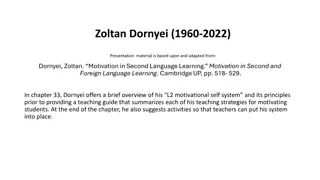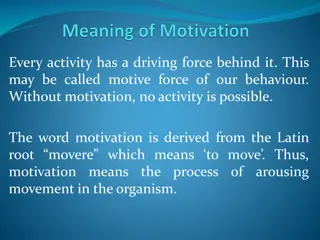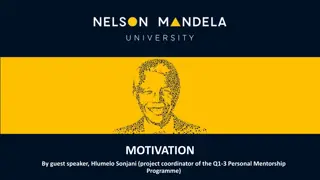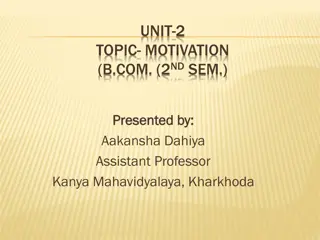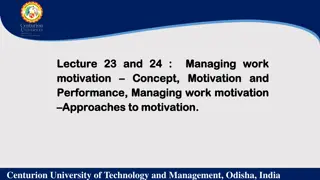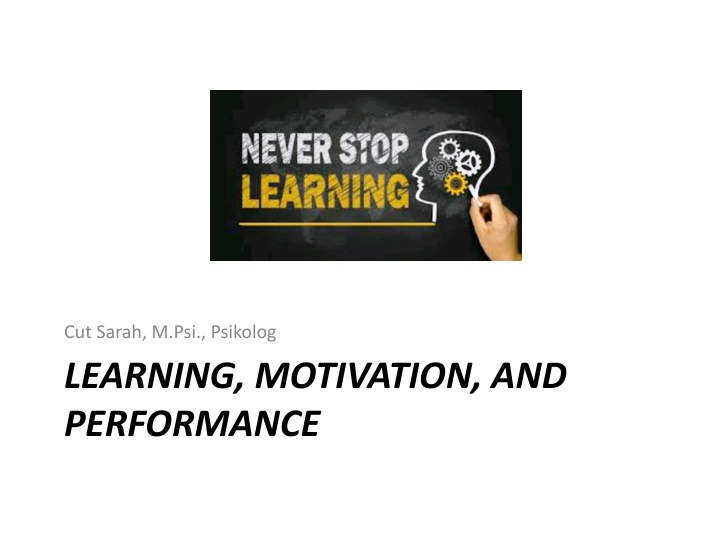
Motivation, Learning, and Performance Insights
Explore the interplay between Knowledge, Skills, Attitudes (KSA), Motivation, and Environment in determining human performance. Delve into theories like ERG Theory by Clayton Alderfer and understand the importance of Self-Efficacy in motivation and learning success.
Download Presentation

Please find below an Image/Link to download the presentation.
The content on the website is provided AS IS for your information and personal use only. It may not be sold, licensed, or shared on other websites without obtaining consent from the author. If you encounter any issues during the download, it is possible that the publisher has removed the file from their server.
You are allowed to download the files provided on this website for personal or commercial use, subject to the condition that they are used lawfully. All files are the property of their respective owners.
The content on the website is provided AS IS for your information and personal use only. It may not be sold, licensed, or shared on other websites without obtaining consent from the author.
E N D
Presentation Transcript
Cut Sarah, M.Psi., Psikolog LEARNING, MOTIVATION, AND PERFORMANCE
Understanding Motivation & Performance Kinerja karyawan, atau perilaku secara umum, adalah fungsi dari apa yang diketahui dan diyakini seseorang (KSAs). Jika karyawan tidak memiliki KSAs, maka ia tidak dapat menunjukkan kinerja yang diharapkan. Selain KSAs, ada faktor lain yang turut mempengaruhi kinerja karyawan.
KNOWLEDGE SKILLS ATTITUDES (KSA) MOTIVATION (M) ENVIRONMENT (E) Factors Determining Human Performance TRAINING DIBERIKAN JIKA TERINDIKASI ADANYA LACK OF KSA S P = M X KSA X E
MOTIVATION: WHY DO THEY ACT LIKE THAT? Motivasi adalah bagian dari struktur kognitif yang tidak bisa diamati secara langsung, jadi dilihat melalui efeknya dalam perilaku, yang dapat diamati. Motivasi arah, ketekunan, dan jumlah usaha yang dikeluarkan seseorang dalam mencapai hasil tertentu (Blanchard & Thacker, 1999). Motivation is goal directed and its explained by both the needs that people have and the decision processthey use to satisfy those needs
Clayton Alderfer (1969) mengembangkan ERG Theory berdasarkan teori dasar Maslow. Asumsinya kebutuhan adalah dasar utama dari motivasi kita. NEEDS THEORY Selain kebutuhan, proses bagaimana cara memenuhi atau memuaskan kebutuhan tersebut adalah bagian penting dari motivasi. PROCESS THEORY
Needs Theory Process Theories Reinforcement Theory- The Environment Existence Needs Relatedness Needs Reinforcement VS Punishment Expectancy Theory Growth Needs
Self-Efficacy & Motivasi Self-efficacy adalah perasaan seseorang tentang kompetensi yang dimilikinya. Beberapa faktor yang mempengaruhi perkiraan karyawan tentang kemampuannya: Prior experience Behavioral models Others feedback Physical and emotional state Self-efficay memainkan peranan penting dalam ekspektansi seseorang. Training dapat meningkatkan self-efficacy. Akan bermanfaat mengukur self-efficacy trainee sebelum mengikuti training karena akan mempengaruhi keberhasilan pembelajaran.
Understanding Learning Definisi learning berdasarkan dua pendekatan: Perubahan perilaku yang relatif permanen. Behaviorist Approach Perubahan dalam isi, organisasi, dan penyimpanan informasi. Cognitive Approach
Implikasi training dari sudut pandang teori belajar kognitif dan behavioral ISU PENDEKATAN KOGNITIF PENDEKATAN BEHAVIORIS Learner s role Active, self directed, self evaluating Passive, dependent Instructor s role Facilitator, coordinator, presenter Director, monitor, evaluator Training content Problem or task oriented Subject oriented Learner motivation internally externally Training climate Relaxed, mutually trustful, respectful, collaborative Formal, authority, judgmental, competitive Instructional goal Collaboratively developed Developed by instructor Instructional activities Interactive, group, project oriented, experiential Directive, individual subject oriented
GAGNEs APPROACH BANDURA s APPROACH Social learning theory- more cognitive More behavioral Peristiwa atau konsekuensi dalam situasi belajar diproses secara kognitif sebelum dipelajari atau mempengaruhi perilaku Ada 8 tipe belajar mulai dari dasar hingga level yang lebih tinggi
LEARNING TYPE DESCRIPTION Learning a general response to a specific signal. Pavlov s classical conditioning falls into this category 1. Signal Learning Learning a single response to a stimulus situation 2. Stimulus- Response (S-R) Chaining together of two or more S-R association 3. Shaping A chain of two or more verbal association. Basically the same as shaping, but the application to language makes this a special case since it involves internal links to language capabilities 4. Verbal Association Ability to make different but appropriate response to stimuli that differ to greater or lesser degrees 5. Multiple Discrimination Reflected by ability to make a common response to a class of stimuli having some common characteristic or relationship but otherwise differing to greater or lesser degrees. 6. Concept Learning 7. Principle Learning Represented by a chain of two or more concepts characterized by the development of a formal logical relation between concepts similar to an if A then B formulation, where A and B are concepts. Involves the retrival of two or more previously learned principles and their combination to produce a novel (to the learner) capability reflecting a higher-order principle. 8. Problem Solving
Why Are They Resisting and What Can I do about It? Resistance to learning Fear of the unknown: Right now I know how things work, but I don t know how this training will affect things. Fear of incompetence: I don t know if I ll able to learn this stuff. Fear of losing rewards: What will happen to my pay, status, perks, etc? Fear of lost influence: Will this training make me more or less valuable? Lost investment: I ve spent a lot of time and energy learning to do it this way, Why change?
Training that motivates adults to learn Training relevance, value, and readiness to learn Allowing trainees control over their learning Involving trainees in the process
Diskusi 1. Paparkan mengenai 1 teori belajar secara komprehensif dan bagaimana teori tersebut dapat diaplikasikan dalam training? 2. Bagaimana training dirancang untuk memotivasi pembelajaran (learning) dan mengakomodir perbedaan dari setiap trainee?
9 prinsip pengembangan training: 1. Identifikasi kekuatan dan kelemahan setiap individu dan sesuaikan dengan kondisi training. Menyelaraskan learning objectives dengan organizational goals. Definisikan tujuan dan sasaran program training dengan jelas di awal. Memaksimalkan perhatian, harapan, dan ingatan trainee secara aktif. Menggunakan aktivitas belajar yang sistematis dan logis sehingga trainee bisa menguasai pembelajaran dari level paling dasar sampai level paling tinggi. Menggunakan metode yang bervariasi. Menggunakan material training yang relevan dengan pekerjaan atau kehidupan sehari-hari. Mempersilahkan trainee untuk bekerja sama dan saling berbagi pengalaman. Memberikan feedback secara berkala dan reinforcement ketika diperlukan. 2. 3. 4. 5. 6. 7. 8. 9.

